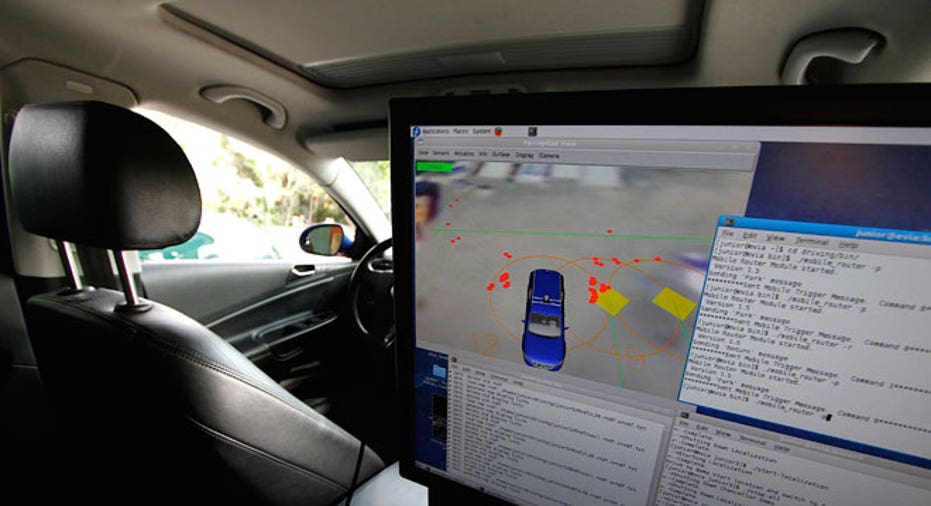Will Driverless Cars Fuel Cheap Insurance?

Google took another step toward bringing driverless cars to future highways when it recently unveiled a small two-seater that doesn't have a steering wheel, brake or gas pedals.
The prototype, which looks more like a revved-up golf cart than a luxury sedan, features a go button and "panic" stop button, and cruises at 25 mph. This significantly differs from earlier Google robot cars that had steering wheels and allowed for humans to take over the control of the car. Google hopes to have 100 of them built by this time next year as experimentation continues, though the company says the bubble-shaped vehicle won't be commercially available for some time.
Still, insurance industry watchers aren't wasting time weighing in on how the types of car insurance that are standard now will change as a result of autonomous cars -- many expect the underwriting process and purchasing cycle to morph into new business models.
Software and Sensors Keeping You Safe
"They won't have a steering wheel, accelerator pedal, or brake pedal … because they don't need them," Google says on its official blog. "Our software and sensors do all the work. And that's an important step toward improving road safety and transforming mobility for millions of people."
The vehicles operate through an array of electronic sensors that, according to Google, can see about 600 feet in all directions. The company adds that the front end will be made from a foam-like material in case the technology failed and the car hit a pedestrian.
Google says the electric cars could be used in low-speed driving environments like crowded downtowns or on corporate campuses and enclosed residential communities. People could use their smartphones to summon the vehicle, which would then take them to a destination. The cars could also be used as self-driving taxis in cities and elsewhere, according to Google.
Sergey Brin, Google's co-founder, reflected on his first ride during a recent Southern California tech conference. "It reminded me of catching a chairlift by yourself, a bit of solitude I found really enjoyable," he told reporters eager to take in any new development by the forward-thinking tech company.
Future testing will continue in California, which allows autonomous vehicles, but only those with manual controls. As widely reported, Google hopes to eventually convince state regulators that the cars can operate safely without driver, steering wheel, brake or accelerator pedal.
Most state and federal regulators have insisted that the vehicles revert to passenger control if the autonomous systems failed.
Are Consumers Ready to Give Up the Wheel? Maybe Not
A CarInsurance.com survey of 2,000 licensed motorists found that only about 20% would happily switch to autonomous cars if they became readily available. The other 80% said they just don't feel comfortable with the technology.
But what if insurance rates would drop significantly in a world with much fewer accidents caused by hapless drivers? More than a third said an 80% cut in premiums, which has been predicted by some analysts, would make it "very likely" that they'd buy a driverless car, and 90% said they would at least consider the possibility.
Here's what turns people off about self-driving cars, according to the survey:
- 64% said computers were not capable of the same quality of decision-making that human drivers exhibit.
- 75% said they can drive a car better than a computer could.
- 75% said they would not trust a driverless car to take their children to school.
No longer facing the job of turning steering wheels, pushing pedals and watching the road, here's what they'd do with the freedom:
- Text/talk with friends: 26%
- Other: 21%
- Read: 21%
- Sleep: 10%
- Watch movies: 8%
- Play games: 7%
- Work: 7%
Will Driverless Cars Mean Cheaper Insurance?
Autonomous vehicles are trumpeted as the logical way to greatly reduce accidents and deaths on our highways. Good for motorists -- but not so good for insurers, according to experts who have studied the issue.
Celent, an international consulting firm, says in its report, "A Scenario: The End of Auto Insurance: What Happens When There Are (Almost) No Accidents," that crashes could drop by nearly 90% if driverless cars prove effective and become the norm during the coming years, causing coverage premiums to plummet.
Donald Light, a Celent researcher, offers various projections, all based on the growth of self-driving cars and other advanced systems like crash-avoidance technology (such as autonomous braking and lane-departure warnings in vehicles) and automated traffic enforcement, such as speed cameras and red-light cameras.
Light says auto liability insurance premiums could fall 20% by 2017 compared to 2012 levels, with comprehensive rates dropping 30%. By 2022, liability premiums could drop 60% to 80% from 2012. He projects rate reductions would accelerate after 2018 as advanced safety technology further takes hold.
Eli Lehrer, an analyst at R Street Institute, points out that the first driverless car may be available in just a few years. But initial models will still require owners to carry liability insurance because they'll have ultimate control of the vehicle and be responsible for any problems, big or small, that occur.
"Some claims will become product liability claims -- some types of accident claims already are -- but most accidents would still result from human error of various kinds," he says. "There isn't going to be a huge change (in the early stages of the technology). The insurance business will continue in much the same way for most insurers and most consumers."
The original article can be found at CarInsurance.com:Will driverless cars fuel cheap insurance?



















